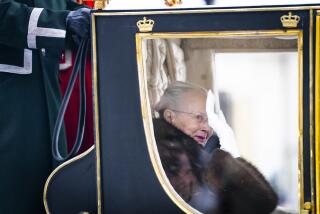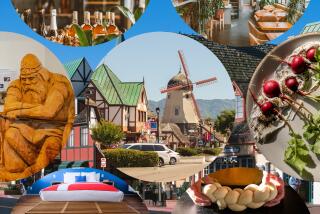Whitsuntide: The Friendly Carnival, Danish Style
- Share via
COPENHAGEN — It’s like taking a deep, courage-bolstering breath before plunging into water you just know is going to be icy cold, and the sigh of relief when the water turns out to be warm and pleasant.
From afar, the huge Town Hall Square here is a maelstrom of color and noise. A youthful mob, clad in bizarre costumes, painted with weird makeup, churns in a writhing mass.
But once you plunge in, trepidations quickly dissipate. The atmosphere is warm and friendly and the attitude is hospitable.
“Hello!” shouts a young man, his fingers splayed on the keys of a pulsating accordion while he deftly clutches a bottle of beer. “Do you speak English?”
This is spring; the flower beds in the nearby Tivoli, perhaps the world’s first theme amusement park, are in full bloom, a lush rampage of color, and the young people of Copenhagen are celebrating Whitsuntide Carnival.
“Where are you from?” calls a girl in a blue chiffon cape, with sunflower-yellow paper petals sprouting from the top of her head, one side of her face painted maroon, the other a garish green.
“The U.S.,” I reply.
“Welcome to Copenhagen.” She grins. “Come enjoy a good Danish beer.”
What seems like a mindless mob has a vaguely discernible pattern. Groups of young people of high school and college age mill about, seeming from time to time to congregate loosely around standards and banners. Here and there, musical groups valiantly try to outdo each other--if not melodically, at least in volume. Omnipresent throughout the square are cases upon cases of green bottles of beer.
Along one side of the square, arm-banded individuals good-naturedly struggle to clear a path for sweaty runners, more than 3,000 of whom are in the 42-kilometer (about 26 miles) Wonderful Copenhagen Marathon that wends on a tortuous route throughout the city. Clearly, the toughest part is finding running room through the mass of humanity gathered in Town Hall Square.
Whitsuntide, the Pentecost observance traditionally held 50 days after Easter Sunday, has long been a legal holiday in Scandinavia and Great Britain, and is observed in other countries. Six years ago it was decided in Copenhagen to create a three-day carnival in conjunction with the observance.
But unlike carnivals in Rio, New Orleans and other cities, the one here is marked by a lack of rowdy behavior and vandalism. The costumes are really quite demure.
World-famous Tivoli amusement park, only about half the size of the 70-acre Disneyland and a fraction of the size of Florida’s Walt Disney World, is open from May 1 to early September, attracting more than 5 million visitors a year.
Despite its small size, it is so artfully designed that within the grounds in the heart of the city are 25 major rides, more than two dozen restaurants, a fairly large boat-filled lake that is part of the old moat that once surrounded the city, an outdoor theater, a bandstand, and the spectacularly colorful gardens that have earned world fame.
At night, although neon lights are forbidden, more than 110,000 colored bulbs illuminate the park in a fairyland glow that would make Hans Christian Andersen proud. Four times a week--on Wednesday, Friday, Saturday and Sunday--a massive fireworks display heralds the close of the park at midnight.
Tivoli was created by a 31-year-old newspaper publisher named Georg Carstensen, a former army officer and the son of a former governor of Algeria, where he was born.
He convinced the Danish king to permit him to use a military training area just outside what was then the city’s west gate to build what he called the Copenhagen Tivoli and Vauxhall. The doors opened on Aug. 15, 1843, and it has been a monumental success ever since.
None of the rides are gut-wrenching thrillers of the type usually found in North American amusement parks. Crowds of wide-eyed youngsters tugging at helium-filled balloons--and their wide-eyed parents tugging at eager children--line up to ride the roller coaster. Built on a gentle scale, with easy slopes instead of sharp drops, and nary a gravity-defying loop-the-loop, it’s designed to resemble an antique steam locomotive and train. But the shrieks of joy and delight are just as loud.
Also unlike those at theme parks in North America, many of the restaurants are designed to accommodate adults rather than cater to the snack-food mania of youngsters. Tivoli restaurants serve alcoholic beverages, something Walt Disney never permitted in his parks during his lifetime. Several of the restaurants offer excellent, almost gourmet-quality food.
Some of the cuisine is international, including American. Per F. Sorensen, who owns and operates the Promenaden restaurant, serves delicious barbecued spareribs and rib-eye steaks, which he learned to make in San Antonio, Tex., where he managed a private club on the grounds of HemisFair, the 1968 world’s fair staged in that city.
Also in the park are small shops containing slot machines similar to those found in casinos. The amounts that can be gambled are small, as are the payoffs, but a constant crowd of youngsters and adults busily yank at the handles, hoping for a row of cherries or other fruits that denote the jackpot.
Despite the fact that Copenhagen was founded more than 800 years ago, in 1167, there’s a delightfully youthful exuberance and innocence about the city. That feeling even extends to Denmark’s monarchy, claimed to be the oldest in the world.
Queen Margrethe II is 46. Last year during Whitsuntide weekend, her oldest son, Crown Prince Frederik, turned 18 and in keeping with tradition was taken to Parliament for the first time.
Colorful Procession
He and his mother then rode through the city to extend greetings to the populace in a colorful procession, the royal duo in an antique open horse-drawn carriage accompanied by a detachment of the Royal Life Guard in bright red and gold-braid uniforms and black and gold-braid hats.
The pair rode in the open carriage without bullet-proof protection and within easy reach of the crowds lining the narrow streets and boulevards, accompanied only by the Royal Life Guard riding horses two-by-two, front and rear. The Danish equivalent of secret- service agents, they managed to keep a low profile.
-- -- --
This year, because Easter falls on April 19, Pentacost/Whit Sunday will be observed on June 7. If the Copenhagen city fathers keep with tradition, that will be the date of the Wonderful Copenhagen Marathon, and the Whitsuntide Carnival will extend from June 6 to 9.
Athletes interested in running in the marathon, and non-athletes interested in attending the carnival, can obtain maps, brochures, dates, marathon entry requirements and other information about Denmark from the Scandinavian National Tourist Offices, 8929 Wilshire Blvd., Beverly Hills 90211; phone (213) 854-1549.
An excellent buy for visitors to Copenhagen is the Copenhagen Card, issued for one, two or three days. It permits unlimited access to Tivoli and many attractions in the park, as well as travel by bus and rail throughout the metropolitan area, admission to 43 museums and attractions, along with discounts of 25% to 50% on the ferry services to Sweden.
The card costs 70 kroner for one day, 120 kroner for two days and 150 for three days (roughly $9, $15 and $18.50).
It is issued by the Copenhagen Tourist Assn., and buyers also get a 90-page pocket-size booklet that contains a map and a brief description of just about every attraction in and around the city.
Excellent Accommodations
Hotel accommodations in Copenhagen are excellent, running from deluxe to economy. Deluxe doubles start at about $125 while economy rooms, without bath, are as low as $35. Two fairly new first-class hotels, one in a converted granary built in 1787, are quite attractive. The 366-room Copenhagen Admiral, and next door, the 134-room Sophie Amalie, are close to Amalienborg Palace, the residence of the royal family. Doubles with bath (including 22% tax and service charge) are in the $92-$100 range.
SAS, the Scandinavian Airline System, also operates two deluxe hotels in Copenhagen, the Royal and the Scandinavia. A double at the Royal, including breakfast, is about $190, while at the Scandinavia the range is $170 to $220. (All U.S. dollar quotes are subject to exchange rate fluctuations.)
The Copenhagen airport, a key point of entry for Northern Europe, is undergoing a badly needed renovation. SAS, phone (800) 221-2350, provides direct service from the United States, as does TWA, phone (800) 221-2000, and Northwest Orient, phone (800) 225-2525.
More to Read
Sign up for The Wild
We’ll help you find the best places to hike, bike and run, as well as the perfect silent spots for meditation and yoga.
You may occasionally receive promotional content from the Los Angeles Times.






